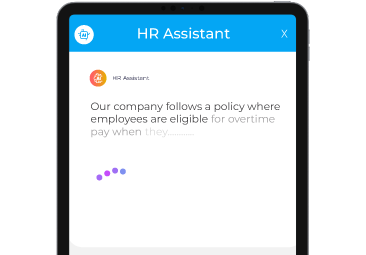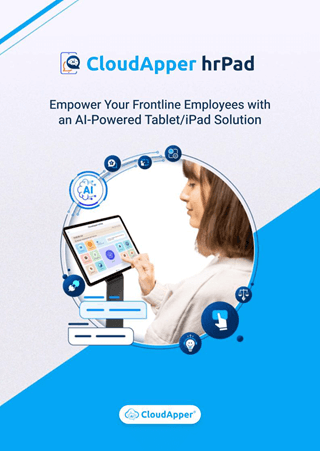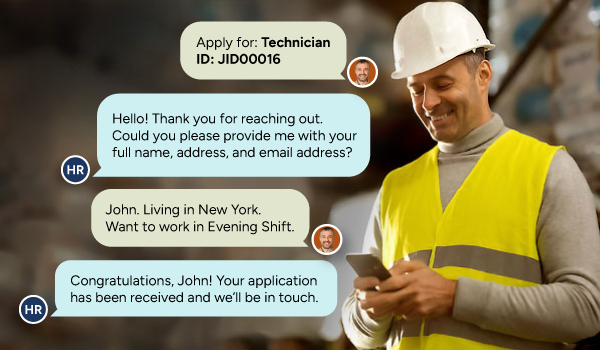Employee turnover is costly and disruptive. Self-service HR tools can address common reasons employees quit, such as lack of career advancement, unclear work-life balance, and inefficient communication, by empowering employees and fostering a supportive work environment.
Table of Contents
Employee turnover is a persistent challenge for many organizations. The loss of talent can be costly, time-consuming, and disruptive. One of the key pain points for HR teams is trying to identify why employees leave—and more importantly, how to stop it from happening. Often, the solution lies in understanding the pain points that lead employees to quit and leveraging self-service HR tools to address them. Here are seven common reasons employees quit and how self-service HR can help solve these issues.
For more information on CloudApper hrPad visit our page here.
1. Lack of Career Advancement Opportunities
Why it hurts: Employees crave growth and development. When they feel stuck in a dead-end job, their motivation plummets, and they begin seeking new opportunities.
How self-service HR helps: By automating performance reviews, goal setting, and career development tracking, self-service HR tools allow employees to take charge of their own growth. They can request training, access learning resources, and track their progress—all at their fingertips.
2. Unclear Work-Life Balance
Why it hurts: Employees want flexibility in how they manage their time, but traditional HR systems often make it difficult to request time off or track leave balances. If employees feel like they have no control over their schedules, burnout can set in.
How self-service HR helps: With a self-service kiosk like CloudApper hrPad, employees can easily manage their time off requests, track PTO, and even swap shifts. This level of autonomy improves work-life balance and empowers employees to manage their schedules more effectively.
3. Inefficient Communication and Lack of Transparency
Why it hurts: Employees who feel out of the loop or disconnected from company goals may struggle with engagement. Poor communication can lead to frustration and misunderstandings, pushing employees to look elsewhere for clarity.

How self-service HR helps: Self-service HR systems often come with 24/7 AI assistants to answer HR queries instantly. From policies to benefits, employees can get the information they need without relying on a busy HR department. This transparency fosters trust and ensures employees feel heard.
4. Inaccurate Payroll and Benefits Issues
Why it hurts: Employees can become disillusioned when their paychecks aren’t accurate or when benefits are difficult to access or understand. Payroll errors or unclear benefits can create unnecessary stress and resentment.
How self-service HR helps: With self-service kiosks, employees can instantly access their pay stubs, review benefits packages, and even make changes to their personal information. They can trust that their compensation and benefits are accurate and easy to manage, which keeps them happy and engaged.
5. Lack of Recognition and Appreciation
Why it hurts: Employees want to feel valued. If they don’t receive recognition for their hard work, they might feel that their efforts are going unnoticed, leading to disengagement and ultimately, resignation.
How self-service HR helps: Self-service tools can integrate feedback mechanisms like surveys or peer recognition features. Employees can nominate their peers for achievements or see their own progress toward company goals, fostering a sense of accomplishment and appreciation.
6. Inflexible or Outdated Technology
Why it hurts: Employees are increasingly tech-savvy and expect their workplace to reflect that. Outdated systems can make tasks more difficult, leading to frustration and disengagement.
How self-service HR helps: Self-service HR tools like hrPad are designed to be intuitive and easy to use. By turning any tablet or smartphone into a powerful HR system, employees can seamlessly access their schedules, timekeeping, and HR services. This flexibility makes HR tasks easier and enhances overall employee satisfaction.
7. Unresolved HR Issues
Why it hurts: When employees have concerns—whether about their roles, workloads, or benefits—and they’re not addressed in a timely manner, they may feel that their voices are not valued. Over time, unresolved issues can drive employees away.
How self-service HR helps: A self-service kiosk with an AI assistant can provide employees with instant answers to HR queries, reducing delays in addressing concerns. Furthermore, features like personalized surveys or feedback options allow employees to raise issues before they escalate, ensuring HR is always in the loop.
Conclusion: Employee turnover doesn’t have to be inevitable. By understanding the reasons employees quit and implementing self-service HR solutions, businesses can create a more engaged, satisfied workforce. Self-service tools empower employees, reduce HR burdens, and foster a culture of transparency and support—ultimately driving better retention rates and a more motivated team.
What is CloudApper AI Platform?
CloudApper AI is an advanced platform that enables organizations to integrate AI into their existing enterprise systems effortlessly, without the need for technical expertise, costly development, or upgrading the underlying infrastructure. By transforming legacy systems into AI-capable solutions, CloudApper allows companies to harness the power of Generative AI quickly and efficiently. This approach has been successfully implemented with leading systems like UKG, Workday, Oracle, Paradox, Amazon AWS Bedrock and can be applied across various industries, helping businesses enhance productivity, automate processes, and gain deeper insights without the usual complexities. With CloudApper AI, you can start experiencing the transformative benefits of AI today. Learn More

Brochure
CloudApper hrPad
Empower Frontline Employees with an AI-Powered Tablet/iPad Solution
Download Brochure
CloudApper AI Solutions for HR



- Works with








- and more.
Similar Posts

Self Service Kiosk vs Front Desk: What Works Best?

How a Self Service Kiosk Transforms Hospitality: A Talk with…






